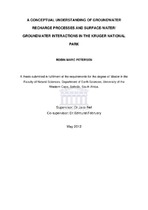| dc.description.abstract | In the Kruger National Park (KNP) which is the flagship conservation area in South
Africa, the impact on groundwater should be kept to a minimum as groundwater plays a vital role in sustaining ecosystem functioning and sustaining baseflow to streams and rivers. For this reason groundwater has been recognized as one of the environmental indicators that need to be monitored. The KNP has adopted a Strategic Adaptive Management (SAM) approach with clear ecosystem management goals. The achievement of these goals is evaluated by using environmental indicators. These indicators are evaluated against thresholds of potential concern (TPC). TPCs are a set of boundaries that together define the spatiotemporal conditions for which the KNP ecosystem is managed. TPCs are essentially upper and lower limits along a continuum of change in selected environmental indicators. Historically, groundwater recharge and surface water interaction with rivers has tended to be overlooked in the KNP. This study proposes a conceptual model of groundwater recharge processes in the KNP, defining when and how groundwater recharge occurs. Two methods were used, the Cumulative Rainfall Departure (CRD) and stable isotopes of ²H and ¹⁸O. An adapted version of the CRD which incorporates a long and short term memory of the system was used to identify possible recharge processes. Further, using the CRD method a reliable reconstruction of the long term groundwater level trends are simulated using monthly rainfall totals with reference to the average rainfall over the entire time series 1936-2009. The stable isotope of ²H and ¹⁸O samples from cumulative rainfall samplers, surfacewater (streams and rivers) and groundwater from boreholes were collected monthly for approximately one year (May 2010 to July 2011). The isotope composition of the groundwater was used to establish whether recharge was immediate or delayed. Additionally, the isotopic composition of surface-water from rivers and streams were compared to that of groundwater to identify surface-water interactions. Groundwater recharge in KNP occurs during the rainy summer months (December to March) and very little to none during the dry winter season (April to September). Recharge takes place during rainfall sequences 100mm or more. The stable isotope records collected from cumulative rainfall, groundwater and surface water (streams and rivers) indicate that groundwater experiences evaporation prior to infiltration. As the KNP experiences high evaporation rates, insignificant rainfall sequences contribute little or zero to recharge. The CRD analysis of groundwater level fluctuations shows that recharge to the aquifers respond to dry and wet cycles that last for 6 to 14 years. The KNP experienced several periods of below-average rainfall and hence no significant recharge took place to the basement aquifers. During a normal rainy season the water levels rise somewhat then starts receding again. It is only during major rainfall events that may occur every 100yrs to 200yrs causing the aquifers to fully recharge. This was perfectly illustrated by the high groundwater levels after the 2000 major rainfall event that recharged the aquifers fully. During below average rainfall years the overall water level trend is drastically declining. The system experiences higher natural losses than gains due to outflow of groundwater to streams and rivers. The KNP is divided down the center by two geological formations, granites along the west and basalts along the east. The combination of the CRD model and the stable isotopic analysis suggest that the dominant recharge processes that occur in the southern region of the KNP are direct recharge via piston flow and indirect recharge via preferred pathways particularly streams and rivers. Along the eastern half of the KNP on the Basalts and Rhyolite direct recharge via piston flow are dominant. Groundwater is not recharged via small streams and rivers (Sweni and Mnondozi Rivers) as it was found that at these particular sites these rivers are detached and do not interact with groundwater. Along the western granitic areas the dominant recharge process are indirect recharge. Recharge takes place via preferred pathways particularly streams and rivers. It was found that ephemeral rivers (Nwatsisonto River) act as sinks for groundwater recharge and influent-effluent conditions are experienced along seasonal rivers (Mbyamiti River). The large perennial Sabie and its tributary the Sand River are consistently fed by groundwater, above all maintaining base flow during the dry season. These rivers act as basin sinks receiving groundwater discharge all year round. Using the stable isotope composition of rainfall, surface-water and groundwater to act as a natural tracer, in combination with the CRD method proved invaluable to confirm the plausible recharge processes. The study provided a conceptual understanding of the groundwater system in the KNP forming the foundation to developing acceptable limits (TPCs) of the groundwater levels in the KNP. The model will serve as a guide for the recharge processes and for deciding on the location and time frames for data collection to ultimately set TPCs for groundwater in the KNP to sustainably manage the resource. | en_US |

